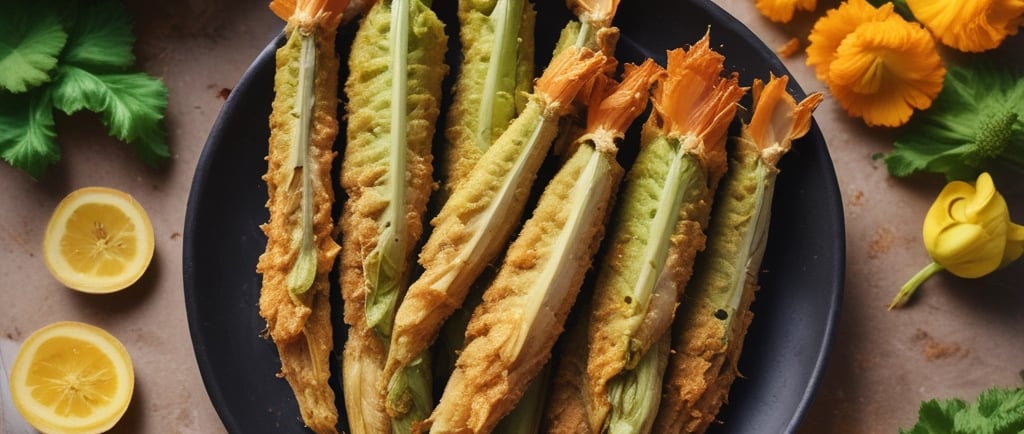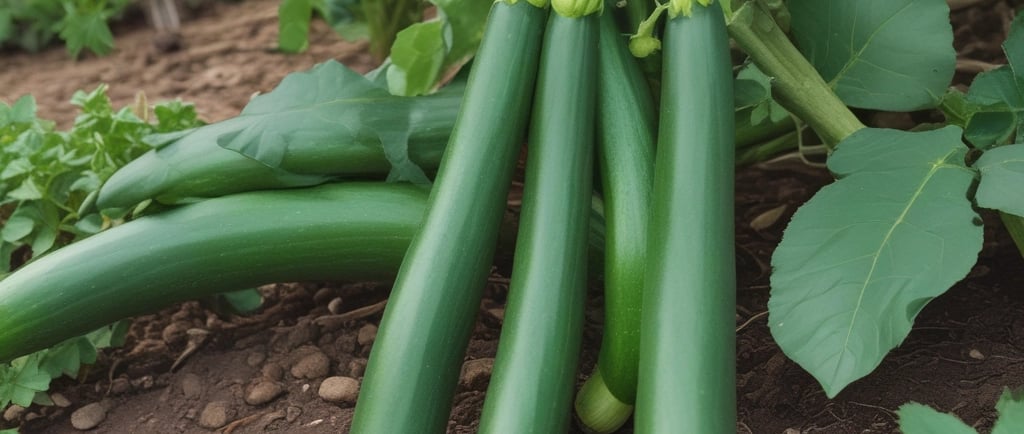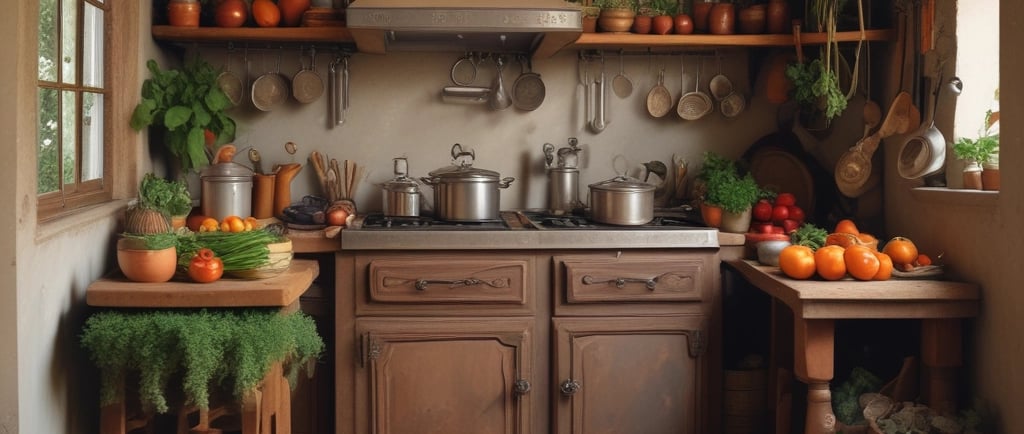The Unassuming Charm of Fried Zucchini Blossoms
Fried zucchini blossoms, or fiori di zucca fritti, are a classic Italian appetizer. These delicate, golden blooms are transformed into a crispy, golden-brown masterpiece, embodying the spirit of zero-waste cooking. A testament to cucina povera, this seasonal treat offers a light, crunchy texture and a subtle, sweet flavor. It's a simple, elegant antipasto that tastes like a summer memory and pure sunshine.
8/24/20256 min read


You know, there’s this whole world of flowers that goes way beyond a beautiful bouquet. We often think of blooms as something to admire or give as a gift, but what if I told you some of the most stunning, ephemeral flowers are meant for the kitchen? It’s true. For a fleeting window each summer, a humble, unassuming bloom takes center stage in kitchens across Italy, and trust me, it’s a moment you’ll want to savor. I'm talking about fried zucchini blossoms, or as they’re known in Italy, fiori di zucca fritti.
These delicate treasures are a testament to the old-world idea of zero waste, long before it became a trend. In Italy, particularly in regions with a rich history of cucina povera (peasant cooking), every part of a plant was prized. The zucchini flower, a beautiful orange-yellow bloom, was no exception. Instead of being discarded, it was transformed into a crispy, golden-brown masterpiece that tastes like pure sunshine. It's an appetizer, or antipasto if you're feeling fancy, that feels both incredibly simple and profoundly elegant.
The first time I tried them, it was on a whirlwind trip to Rome. We were walking through a local market, and there they were—piles of them, looking so fragile and vibrant. A little old lady, with a twinkle in her eye, was selling them from a small stand. We bought a few, and she insisted we eat them immediately. Honestly, that first bite was a revelation. The crunch of the light batter gave way to the subtle, almost sweet, flavor of the blossom itself. It was crispy, not greasy, and left a whisper of salt on my lips. It was a flavor that tasted like a summer memory, one I didn't even know I had.


Zucchini Blossoms for the Flower Enthusiast
If you’re a home gardener or someone who loves flowers, you might be curious about where these blossoms come from. Here’s a little secret: zucchini plants produce both male and female flowers. The female flowers are the ones that grow at the end of the zucchini fruit itself. The male flowers, however, have a long, slender stem and are typically the ones you see sold in markets. Why? Because you can harvest the male flowers without affecting the plant's ability to produce fruit. It's a win-win! You still get your zucchini harvest, and you get to enjoy these beautiful blossoms as well.
Now, before you go dipping them in just any old batter, let's talk about the key to success. This isn't your average deep-fry job. The art of a perfect fried zucchini flower lies in the batter itself. It needs to be airy, light, and just substantial enough to cling to the delicate petals without weighing them down. This is where a little bit of science and a whole lot of intuition come into play. Many traditional recipes call for using cold sparkling water or even beer in the batter. The carbonation creates tiny air bubbles that puff up when they hit the hot oil, resulting in that incredibly airy and crispy shell.
I’ve seen folks get a little too worried about the exact measurements. Honestly, it's more of a feel thing. My Nonna would always say, "Just add a little bit more until it feels right." The batter should have the consistency of a thin pancake mix—not too runny that it drips right off, but not so thick that it makes a heavy crust. It's a dance, really. You have to trust your gut and your senses. You'll know it's ready when the batter beautifully coats a spoon but still flows smoothly off the back.


The Great Debate: To Stuff or Not to Stuff?
Here’s where things get interesting. While a simple, un-stuffed zucchini blossom is a beautiful thing on its own, many Italian regions take it one step further by stuffing them. This is where you can really get creative and put your own spin on a classic.
The most traditional Roman stuffing involves a tiny cube of mozzarella and a salted anchovy. Now, if you're thinking, "Anchovies? Really?" hear me out. The salty pop of the anchovy melts into the creamy mozzarella, creating a briny, savory counterpoint to the sweetness of the blossom. It's a flavor profile that’s absolutely unforgettable.
But hey, if anchovies aren’t your thing, there are so many other options. A simple ricotta filling, often mixed with a bit of grated Parmesan cheese, fresh herbs like basil or mint, and a whisper of lemon zest, is a fantastic alternative. It’s creamy, tangy, and complements the delicate flavor of the flower beautifully. And honestly, for a home cook, a ricotta filling is a bit more forgiving to work with than trying to wrangle an anchovy and a piece of mozzarella into a fragile bloom. The trick is to fill them just enough so they don’t burst while frying. A small spoon or a piping bag makes this a whole lot easier, for sure.
It's one of those cooking experiences that forces you to slow down and be present. You have to handle each squash flower with care, gently cleaning it, and then meticulously filling and frying each one. It’s not a rushed process, but a rhythmic, almost meditative one. When you're done, you're left with a platter of golden treasures that are almost too pretty to eat—almost.


Zucchini Blossoms FAQs
Q: Are zucchini blossoms the same as squash blossoms?
A: Yes, they are! Zucchini is a type of summer squash, so the terms zucchini blossoms and squash blossoms are often used interchangeably. You might also hear them called courgette flowers, especially in the UK and Australia.
Q: Can you eat the stamen and pistil inside the flowers?
A: While they are edible, most recipes recommend removing the stamen (in the male flower) or pistil (in the female flower) before cooking. They can sometimes impart a slightly bitter taste. Gently pull back the petals and pinch or cut out the inner part. It's a good practice to ensure the most delicate flavor.
Q: Where can I find fresh zucchini blossoms?
A: The best place to find them is at a local farmers' market during the late spring and summer months. Since they are incredibly delicate and have a short shelf life, you won't often find them in a conventional supermarket. If you have a garden, you can also grow them yourself!
Q: What's the best oil for frying them?
A: You'll want an oil with a high smoke point and a neutral flavor. Sunflower oil is a classic choice in Italy, but vegetable oil or canola oil also work perfectly. The key is to get the oil hot enough (around 350-375°F or 180-190°C) so the blossoms fry up quickly and don’t absorb too much oil, which would make them greasy.


Why This Recipe Resonates
This dish isn't just about food; it's about a feeling. It's about taking something so delicate and transforming it into something crispy and comforting. It’s about celebrating the fleeting moments of summer—the ones that are here for just a little while, and then gone until next year. The preparation of these fried zucchini blossoms is an act of love, a nod to tradition, and a perfect way to bring a little bit of Italian sunshine into your own home.
Think about it: whether you're a florist arranging a stunning centerpiece or a home cook preparing a platter of these golden delights, you're working with the same fundamental thing—the beautiful, natural world around you. You're just expressing its beauty in a different way. Honestly, you can't go wrong. Serve them with a simple squeeze of lemon or a sprinkle of flaky sea salt, and you've got yourself a taste of Italian summer on a plate. It’s a moment of joy, a bite of history, and a really, really good excuse to get a little flour on your hands.
Elegance
Global blooms delivered with care and style.
Sustainability
Support
Open Mon-Fri (exec Public Holidays)
We reply to emails quickly
© 2024. All rights reserved.
